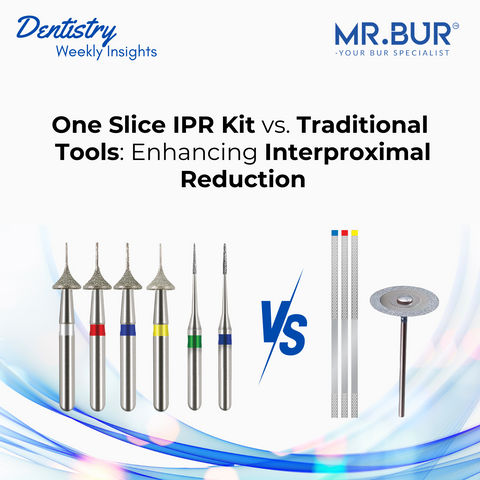Interproximal Reduction (IPR) is a critical technique in orthodontics, particularly for cases requiring better tooth alignment or space creation. This article explores the five most common types of braces, explaining how they function and the role of IPR burs in enhancing treatment outcomes for dental professionals.
Types of Braces in Orthodontics
1. Metal Braces (Traditional Braces)
Metal braces are the most common type, using stainless steel brackets and wires to align teeth over time. They are highly effective for treating complex cases of crowding, misalignment, and bite issues.
2. Ceramic Braces
Ceramic braces are similar to metal braces but use tooth-colored brackets, making them less noticeable. They offer an aesthetic alternative while maintaining effectiveness in moderate to severe misalignment cases.
3. Lingual Braces
Lingual braces are placed on the inner surfaces of the teeth, making them virtually invisible from the front. They are custom-made to fit the shape of each patient’s teeth, making them a popular option for aesthetic-focused treatment.
4. Self-Ligating Braces
Self-ligating braces use a clip mechanism instead of elastics to hold the wire in place, reducing friction and allowing for more efficient movement of teeth. These braces can be made from metal or ceramic and are suitable for moderate to severe cases.
5. Clear Aligners (e.g., Invisalign)
Clear aligners are made from transparent plastic and are designed to gradually shift teeth into proper alignment. They are popular for adults and teens due to their discreet appearance and removability.
Guide to Tooth Preparation for Braces
Before placing braces, dentists follow a series of critical steps to ensure that the treatment plan is suitable for the patient’s dental condition and needs. Here’s what typically happens before braces are applied:
1. Initial Consultation and Assessment
- Medical and Dental History Review: Dentist gathers information about the patient's medical and dental history, including any allergies, previous dental treatments, and general health conditions that may impact orthodontic treatment.
- Physical Examination: The dentist performs a thorough oral examination to check the overall health of the teeth, gums, and jaw.
- Discussion of Concerns and Goals: Patients are encouraged to discuss their concerns and treatment goals. The dentist explains the potential outcomes, treatment duration, and the types of braces that may be suitable.
2. Diagnostic Records
- X-Rays (Radiographs): Dentists take panoramic or cephalometric X-rays to get a clear view of the teeth, roots, and jawbone structure. These images help identify underlying issues like impacted teeth, root alignment, and bone health.
- Intraoral and Extraoral Photographs: Photographs of the patient’s mouth, teeth, and facial structure are taken for documentation and treatment planning.
- Dental Impressions or Digital Scans: Dentists create impressions of the teeth using traditional trays with alginate material or digital scanners. These impressions help create models of the patient's bite, which are used for treatment planning and bracket placement.
3. Orthodontic Treatment Planning
- Detailed Analysis of Alignment Issues: Using the diagnostic records, dentists assess the alignment, spacing, crowding, and bite issues to determine the most effective treatment approach.
- Treatment Plan Development: The dentist develops a customized treatment plan, outlining the type of braces, treatment duration, and any additional procedures required (e.g., extractions or Interproximal Reduction - IPR).
4. Tooth Preparation (Including IPR)
Tooth preparation before braces placement is a critical step in ensuring successful orthodontic treatment. However, several common issues can arise during this phase that may affect the overall outcome. Here’s a breakdown of the preparation steps, highlighting potential challenges:
a. Interproximal Reduction (IPR) Challenges
- Inconsistent Enamel Reduction:
- Achieving the right amount of enamel reduction is crucial for creating sufficient space without compromising tooth integrity. Inconsistent reduction can lead to inadequate space for tooth movement or excessive enamel loss.
- To minimize this risk, dentists use calibrated IPR burs like the Mr. Bur One Slice IPR Kit, which offers precise enamel removal and allows for controlled cutting.
- Difficulty Reaching Tight Spaces:
- Accessing crowded interproximal areas can be challenging, especially in patients with severe crowding. In such cases, using thinner IPR burs and sequentially increasing the width of the bur helps ensure better reach and space creation.
- Patient Sensitivity:
- Reducing enamel can sometimes lead to heightened tooth sensitivity, especially when deeper enamel layers are exposed. To prevent discomfort, dentists use slow, gentle strokes with constant water irrigation during IPR, reducing heat generation and protecting the dentin.
b. Tooth Extraction
- In severe crowding cases, IPR alone may not create sufficient space for alignment, making tooth extraction necessary. Tooth extraction can be a complex decision, depending on the degree of crowding, tooth position, and overall treatment plan. Dentists need to consider extraction as a last resort and communicate the benefits and risks to the patient.
c. Teeth Cleaning Challenges
- Persistent Plaque or Tartar:
- In some cases, patients may have stubborn plaque or tartar deposits, particularly around the gingival margins or interproximal areas. These deposits can hinder proper bracket bonding and increase the risk of decay during treatment.
- To address this issue, a thorough professional cleaning using ultrasonic scalers and hand instruments is performed before braces placement. Dentists may also use polishing burs to remove surface stains and ensure a smooth, clean tooth surface for effective bonding.
- Gum Inflammation (Gingivitis):
- Plaque buildup often leads to gingival inflammation, which can make cleaning more difficult and increase bleeding during preparation. Dentists may recommend a round of professional cleaning and improved oral hygiene practices before braces placement.
d. Fluoride Application Issues
- Patient Allergies or Reactions:
- While rare, some patients may have allergies to certain fluoride varnishes or the taste of fluoride products, making application uncomfortable or causing mild reactions. In such cases, hypoallergenic fluoride alternatives may be used.
- Inadequate Fluoride Retention:
- After fluoride varnish application, patients must avoid eating, drinking, or rinsing for a specific time to allow for optimal fluoride absorption. Failure to adhere to these instructions can reduce the varnish's effectiveness, leaving the enamel more vulnerable to decay during treatment.
e. Bracket Bonding Issues
- Enamel Surface Quality:
- If the enamel surface is too smooth or if there’s residual debris, the brackets may not bond securely. Dentists sometimes use finishing burs to create a slightly roughened enamel surface, which improves bonding strength.
- Moisture Control:
- Moisture from saliva, blood, or even patient breathing can interfere with bracket bonding. Dentists use suction devices, cheek retractors, and cotton rolls to maintain a dry field during bonding.
- Bracket Positioning:
- Misaligned brackets can affect tooth movement, prolonging treatment time. To prevent this, dentists use bracket placement jigs and careful visual assessment to ensure accurate positioning during bonding.
5. Braces Placement
- After all necessary preparations, dentists proceed with the actual placement of the braces. This involves:
- Applying a Bonding Agent: A bonding agent is applied to the teeth to secure the brackets.
- Placing Brackets and Wires: Brackets are positioned on each tooth, and an archwire is threaded through the brackets to begin the process of tooth movement.
6. Patient Education
- Braces Care Instructions: Dentists provide detailed instructions on how to care for braces, including brushing, flossing, and dietary restrictions.
- Oral Hygiene Guidance: Patients are instructed on how to maintain optimal oral hygiene to prevent plaque buildup, gum disease, or tooth decay while wearing braces.
By following these comprehensive steps, dentists ensure that the patient is fully prepared for braces placement, minimizing complications and optimizing treatment outcomes.
Problems During Braces Treatment
- Discomfort and Soreness
- Bracket or Wire Breakage
- Oral Hygiene Challenges
- Tooth Decalcification and White Spots
- Wire Poking or Causing Irritation
-
Gum Overgrowth (Gingival Hyperplasia)
Problems After Braces Removal
- Teeth Relapse (Shifting)
- Staining or Discoloration
- Residual Adhesive
- Gum Recession
- Black Triangle
- Bite Issues
Summary
Effective orthodontic treatment starts with the right preparation, careful planning, and the use of precise tools like IPR burs. From understanding the types of braces to handling common tooth preparation challenges, each step is crucial to achieving optimal patient outcomes. With innovations like the Mr. Bur One Slice IPR Kit, dentists can address issues like crowding more accurately, ensuring smoother treatment and better results. By implementing these strategies, dental professionals can enhance the efficiency of braces placement and improve the overall patient experience, leading to long-term success in orthodontic care.
Discover More:
- Biological and Biomechanical Impacts of Interproximal Reduction (IPR) Burs on Periodontal Health and Enamel Integrity: A Longitudinal Study
- The Role of Interproximal Reduction (IPR) in Clear Aligner Therapy: A Critical Analysis of Indications and Techniques
- Step-by-step guide to Interproximal Bur Technique: The bur used for IPR
Diamond Burs, Carbide Burs, Surgical & Lab Use Burs, Endodontic burs, IPR Kit, Crown Cutting Kit, Gingivectomy Kit, Root Planning Kit, Orthodontic Kit, Composite Polishers, High Speed Burs, Low Speed Burs







